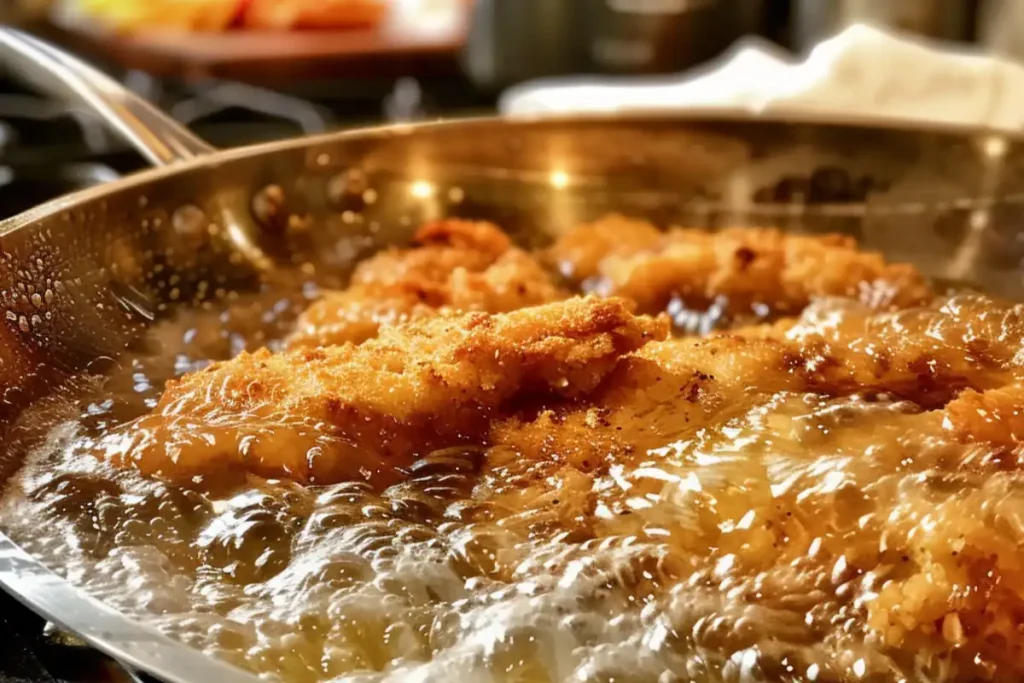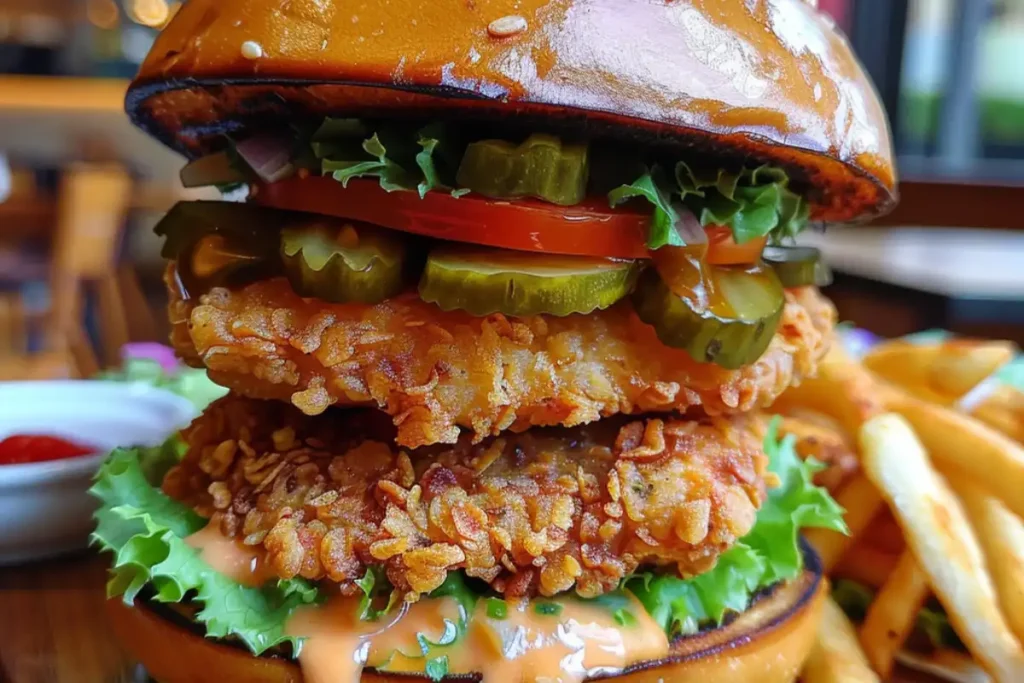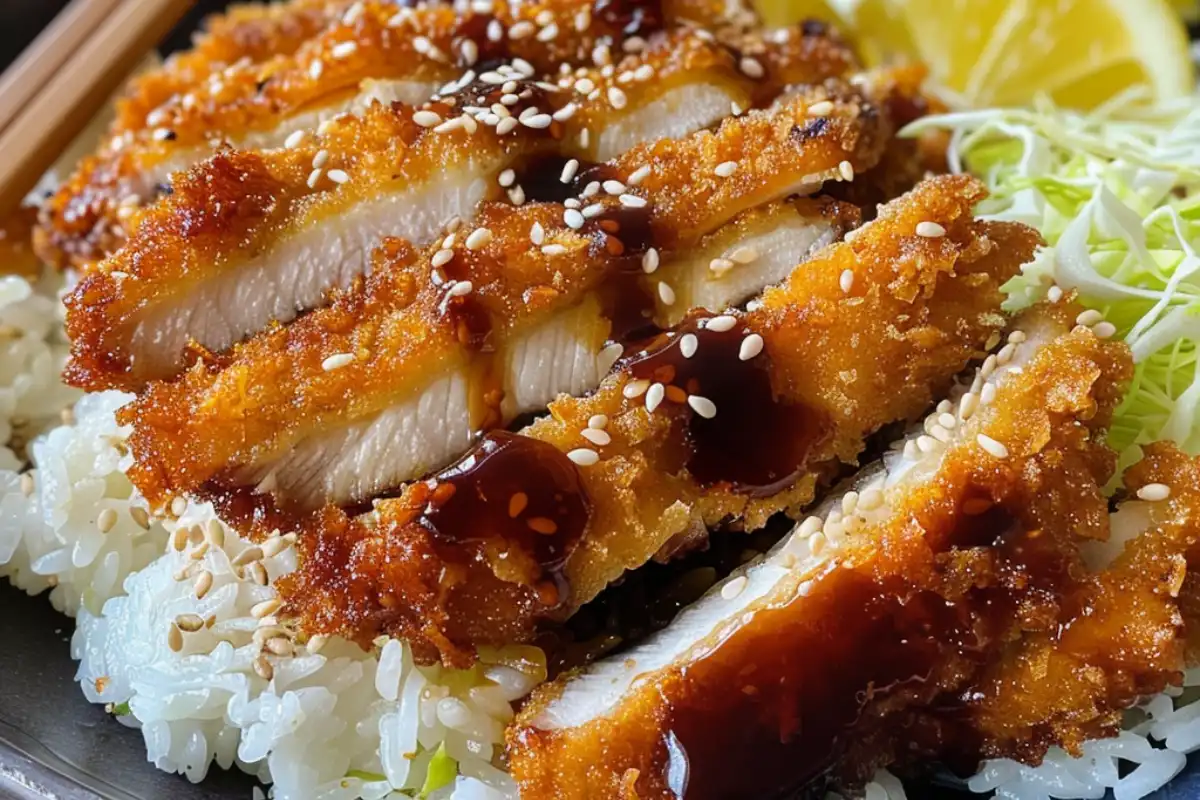Chicken Katsu is a popular Japanese dish that’s found its way into hearts and kitchens around the world. Known for its crispy, breaded exterior and tender, juicy interior, it’s a versatile meal often served with rice, shredded cabbage, and katsu sauce. This comfort food is simple yet satisfying and can be made in various ways, from traditional frying to healthier baking methods.
In this comprehensive guide, we’ll explore what makes chicken katsu so special, dive into the key ingredients, discuss the different preparation techniques, and even touch on some creative variations. If you’re looking to expand your knowledge of Japanese cuisine or simply want to perfect your recipe, this guide will give you all the information you need.
Table of Contents
What Is Chicken Katsu?
Chicken katsu features a breaded and fried chicken cutlet, typically made with boneless, skinless chicken breasts. The word “katsu” comes from the Japanese term for “cutlet,” which derives from the English word. While tonkatsu uses pork cutlets, chicken katsu offers a lighter yet equally flavorful alternative, becoming a staple in both traditional Japanese meals and fusion dishes.
Whether you enjoy it with rice and shredded cabbage or inside a sandwich, chicken katsu stands out for its crispy texture and savory taste. This versatile dish appears in Japanese restaurants, lunchboxes, and trendy cafes.
Core Ingredients
The beauty of this recipe lies in its simplicity. The core ingredients are few, but each plays an important role in creating the perfect cutlet:
- Chicken: Boneless, skinless chicken breast usually takes center stage in this dish, though chicken thighs can provide a juicier result. Pound the meat to an even thickness to ensure consistent cooking.
- Panko Breadcrumbs: Panko is the Japanese version of breadcrumbs, known for being lighter and crispier than traditional breadcrumbs. This gives the chicken its characteristic crunch. Compared to regular breadcrumbs, panko flakes are larger and stay crispier longer after frying.
- Flour and Eggs: Coat the chicken in flour first, then dip it in beaten eggs before breading. The flour allows the egg to adhere to the meat, while the egg helps the panko stick to the chicken, creating an even, crunchy crust.
- Seasonings: Use a simple blend of salt, pepper, and occasionally garlic powder to season the flour and chicken. These seasonings enhance the chicken’s flavor without overpowering the dish.
- Katsu Sauce: Katsu sauce is a tangy, savory condiment made from ingredients like soy sauce, vinegar, sugar, and fruit. It’s often described as a Japanese version of barbecue sauce and pairs beautifully with the crispy chicken cutlet.
For those wondering what makes chicken katsu so crispy, it's all about using the right breadcrumbs. Learn more in this Guide to Japanese Panko Breadcrumbs and see how they compare to regular ones.
The Breading and Cooking Process
How to Bread Chicken Katsu
The hallmark of chicken katsu is its crispy, golden-brown coating. Achieving the perfect breading is a crucial step, and here’s how to do it:
- Prepare the Chicken: Start by pounding the chicken to an even thickness, around half an inch. This ensures that the chicken cooks evenly and quickly.
- Flour the Chicken: Lightly dredge the chicken in flour. Be sure to shake off any excess, as too much flour can create a soggy texture.
- Dip in Egg: After the chicken has been floured, dip it into a bowl of beaten eggs. This layer will help the panko breadcrumbs adhere to the chicken.
- Coat with Panko: Press the chicken into a plate of panko breadcrumbs, making sure each piece is thoroughly coated. The breadcrumbs should stick well to the egg-covered chicken, creating a thick, crunchy exterior.
Cooking
Once the chicken is breaded, it’s time to cook it. There are several methods to choose from, each offering a slightly different outcome in terms of crispiness and healthfulness.
Traditional Frying Method

The most popular way to cook chicken katsu is by deep frying. Frying in oil gives the chicken a golden, crispy crust while keeping the inside tender and juicy. Here’s how to do it:
- Heat about an inch of oil in a deep skillet or pot to 350°F (175°C).
- Fry each piece of chicken for 5-6 minutes per side until golden brown and cooked through.
- Transfer the fried chicken to a wire rack to drain off excess oil. Using a wire rack instead of paper towels helps keep the chicken crispy.
Healthier Alternatives
For those who prefer a healthier option, chicken katsu can be baked or pan-fried with less oil.
- Baking: Preheat your oven to 400°F (200°C), place the breaded chicken on a baking sheet lined with parchment paper, and bake for about 25 minutes, flipping halfway through to ensure even browning.
- Pan-Frying: You can also opt to pan-fry the chicken in a small amount of oil. This method uses less oil than deep frying but still produces a crispy exterior.
Serving Suggestions and Accompaniments
One of the reasons chicken katsu is so beloved is its versatility. It pairs well with a variety of sides and sauces, making it a flexible dish for any meal.
Classic Side Dishes
- White Rice: Rice is the most common side dish served with this recipe. The mild, fluffy rice helps balance out the rich flavors of the fried chicken and katsu sauce.
- Shredded Cabbage: In Japan, chicken katsu is often served with finely shredded cabbage. The fresh, crunchy texture of the cabbage provides a nice contrast to the fried chicken and acts as a palate cleanser.
- Pickled Vegetables: Pickled daikon radish or other vegetables can add a tangy bite that complements the savory chicken cutlet.
Creative Serving Options
Beyond the traditional rice and cabbage combination, there are many creative other ways :
- Katsu Curry: One of the most popular variations is serving it with Japanese curry. The crispy chicken pairs perfectly with the thick, slightly sweet curry sauce. This combination is often referred to as katsu curry.
- Katsu Sandwich (Katsu Sando): Another delicious option is to serve it between slices of bread, along with shredded cabbage and a drizzle of katsu sauce, to create a katsu sandwich. This dish, known as katsu sando, is a favorite in Japanese cafes and convenience stores.
- Salads: For a lighter meal, slice the crispy chicken cutlet and place it on top of a fresh salad. Add a simple vinaigrette or drizzle of katsu sauce for extra flavor.
For more ideas on how to use chicken katsu, you can explore this guide on Chicken Katsu Ramen
Nutritional Information
Like many fried dishes, chicken katsu is delicious but can be high in calories and fat. However, by choosing alternative cooking methods like baking or pan-frying, you can enjoy a healthier version of this dish.
Caloric Content
- A typical serving of fried chicken katsu can range between 500-700 calories, depending on the size of the chicken cutlet and the amount of oil used. Baking or pan-frying the chicken will reduce the calorie count by cutting down on the amount of oil absorbed during cooking.
Healthier Modifications
- For a lighter version of chicken katsu, consider baking or pan-frying the chicken, and using skinless chicken breast to reduce fat. Pairing the dish with vegetables or salad instead of rice can also help reduce the overall calorie content.
Variations

While the traditional chicken katsu recipe is a classic, there are many variations you can try depending on your preferences and dietary needs:
Spicy Chicken Katsu
- For a spicier twist, add chili powder or cayenne pepper to the flour mixture before breading the chicken. You can also serve the chicken with a spicy dipping sauce like sriracha mayo or spicy tonkatsu sauce for an extra kick.
Katsu with Japanese Curry
- One of the most popular variations is serving it with Japanese curry. The rich and slightly sweet curry sauce pairs beautifully with the crispy chicken. This combination is often called katsu curry and is a popular comfort food in Japan.
Chicken Katsu in Burgers or Wraps
- For a modern twist, use chicken katsu in a burger or wrap. Add fresh vegetables like lettuce, tomato, and pickles, and drizzle with katsu sauce or spicy mayo for a delicious fusion meal.
If you're interested in a pork-based version, check out this Pork Chop Casserole Recipe for another delicious option.
Whether you’re enjoying chicken katsu in its traditional form with rice and cabbage or experimenting with variations like katsu curry or sandwiches, there’s no denying that this dish is a winner in terms of flavor and texture. With its crispy exterior and juicy interior, this recipe is easy to make at home and can be adapted to suit various tastes and dietary needs.
Frequently Asked Questions (FAQs)
What is chicken katsu made of that gives it its crispy texture?
- The crispy texture comes from panko breadcrumbs, which are lighter and airier than regular breadcrumbs.
Can I make chicken katsu gluten-free?
- Yes! Substitute all-purpose flour with almond flour and use gluten-free panko.
What’s the difference between chicken katsu and tonkatsu?
- Chicken katsu is made with chicken, while tonkatsu is made with pork cutlets.
How do I keep chicken katsu crispy?
- Let it rest on a wire rack after frying instead of placing it on paper towels.
What Is Chicken Katsu Made Of?
This Chicken Katsu is a crispy, golden-brown Japanese-style fried chicken cutlet coated in crunchy panko breadcrumbs. Served with a rich tonkatsu sauce, it’s perfect for rice bowls, sandwiches, or bento boxes! 🍗🔥
- Prep Time: 10 minutes
- Cook Time: 15 minutes
- Total Time: 25 minutes
- Category: Lunch
- Method: Fried
- Cuisine: Japanese
Ingredients
For the Chicken Katsu:
- 2 boneless, skinless chicken breasts (halved lengthwise for cutlets)
- ½ cup all-purpose flour
- ½ tsp salt
- ½ tsp black pepper
- 2 large eggs, beaten
- 1 cup panko breadcrumbs
- ½ cup vegetable oil (for frying)
For the Tonkatsu Sauce:
- ¼ cup ketchup
- 2 tbsp Worcestershire sauce
- 1 tbsp soy sauce
- 1 tbsp honey or brown sugar
- ½ tsp Dijon mustard
- ¼ tsp garlic powder
Instructions
-
Prepare the Chicken:
- Place chicken breasts between plastic wrap and pound to ½-inch thickness.
- Season both sides with salt and black pepper.
-
Bread the Chicken:
- Dredge chicken in flour, ensuring a light, even coating.
- Dip into beaten eggs, then press into panko breadcrumbs, fully coating each piece.
-
Fry the Chicken:
- Heat vegetable oil in a skillet over medium heat.
- Fry each cutlet for 3-4 minutes per side until golden brown and crispy.
- Drain on a paper towel-lined plate.
-
Make the Tonkatsu Sauce:
- In a small bowl, mix ketchup, Worcestershire sauce, soy sauce, honey, mustard, and garlic powder until smooth.
-
Serve & Enjoy:
- Slice chicken katsu into strips and drizzle with tonkatsu sauce.
- Serve with steamed rice, shredded cabbage, or miso soup.
Notes
- For extra crispiness, double-coat the chicken in panko.
- For a lighter version, bake at 400°F (200°C) for 20 minutes instead of frying.
- For a spicier kick, mix sriracha into the tonkatsu sauce.


